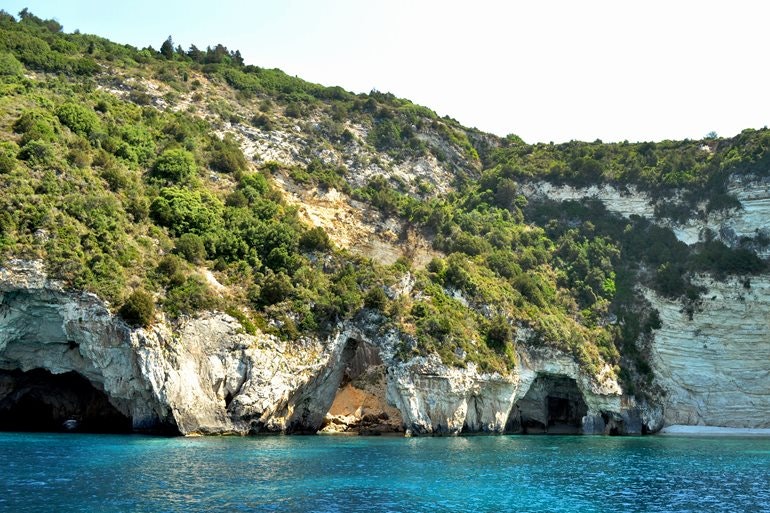Paxos and Antipaxos
Paxos is a green garden of olive groves, colourful flowers on rare plants, small vineyards, interwoven with stone walls and zigzagging paths that invite inquisitive adventurers to explore the countless magical locations of the island. The entry is the picturesque Gaios Harbour, formed by the narrow strait between the small island of Saint Nikolaos and the island of Paxos.
Last, but not least, Paxos is the perfect location for divers and enthusiastic snorkelers. Divers should situate their dives primarily on the western coast of the island, where there are unique sea caves that radiate an unbelievable range of blue colours, from pronounced turquoise to deep blue. In the same part of Paxos, on the seafloor itself, you will find a famed panorama of coral reefs abundant with undersea life.
The western coast of the island also provides yachtsmen with a great opportunity for relaxation, as even in high season here you can fully enjoy the intimacy of small beaches and lonely coves, and often you can anchor in absolute solitude. Sail just off the coast and drop anchor in the bay that fascinates you the most, ideally in the morning to mid-morning before the breeze picks up.
The small island of Antipaxos, located southeast of Paxos, offers several wonderful places to start your sea spa treatment. Worth highlighting is the beautiful and long Vrika Beach at the north of the island, which is covered with snow-white sand with a sea of turquoise blue. However, it is necessary to get up in the morning and get there in time before the beach is inundated with tourists from the cruise ships, or visit the location late in the afternoon. It is only 3 NM to the port of Gaios from there. Unlike Paxos, Antipaxos is set amidst bucolic vineyards, whose liquid alcoholic products will be offered to you in the local taverns.
The Blue Lagoon is located at the northeastern end of Antipaxos Bay. The turquoise water and the long sandy beach attracts dozens of boats. We recommend going ashore as early as possible in the morning, preferably at dawn to enjoy the beach without people. Cruise ships with tourists arrive around 11:00 and then this beautiful beach becomes a mere tourist attraction. Weigh anchor around 11:00 and head off to the western coast of the island (if the west wind is not blowing) and enjoy swimming and diving in the romantic little bays amongst the rocks.
Gaios Harbour
This harbour offers water, electricity, restaurants and shops. If you do not find a place at the pier (which is very likely, especially if you arrive late in the afternoon), you can dock in the northern section of the strait, facing the ferry pier by dropping anchor from the bow of the boat, and tie off the stern on the rocks of the isle of St Nikolaos. You can get to the town by dinghy, or you can move there in the morning with the whole boat when the pier is freed up. The harbour is wonderfully protected.
Another option for anchoring is the small port of Mongonissi on the island of the same name, south of Gaios, which is connected to Paxos by a bridge. There is a nice, sandy beach with a pleasant restaurant and a magnificent view of the surrounding scenery with the dominating island of Antipaxos. You can get to Gaios from here with a 30 minute stroll along the waterfront road. For lovers of tranquil and free anchorage, we recommend Meassalongi Bay, 2 NM south.
Another harbour you should not miss is Lakka, to the north of Paxos. This magical harbour is located in a well-protected bay. It will be easier to find a place to anchor here than at the small waterfront where barely 20 boats fit. If you stop at Lakka for breakfast on your way to Corfu from Gaios, you will want to stay here for lunch, and dinner, too! Beautiful walks take you to the northern Paxos lighthouse, with beautiful views of the open sea and Corfu.

The most romantic anchorage in Parga is near the island of Nea Panagia. You can anchor at its northeastern end and tie up to the bank with a rope. You will be protected from waves by the island, and it is only about 200 m to the shore with a dinghy. There is wonderful snorkelling around the island and its surrounding cliffs. From the boat, you will have a view of Parga. Watch out when anchoring and do not get too close to the shallow nook connecting the island of Nea Panagia to the coastline. Parga Harbour is the most picturesque harbour in the entire area. The colourful houses at the waterfront and the old fortress above the town create a beautiful backdrop. You will also find narrow lanes with many shops and restaurants worth visiting.


